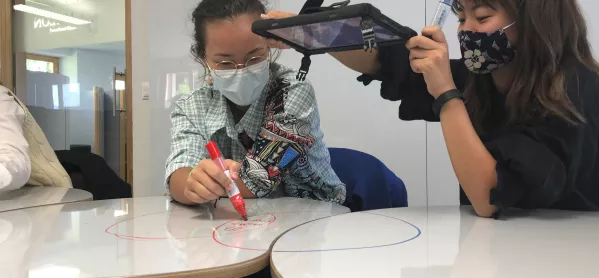- Home
- 6 ways hybrid teaching has boosted learning
6 ways hybrid teaching has boosted learning

Coming back in September was fantastic - but it came with several new issues to contend with.
Most notably, we had a situation whereby some students were unable to return, we had some students whom we had to quarantine and others who were able to get back into the classroom (after being tested) immediately.
This meant running lessons for physically present students, students on-site but in quarantine and students accessing lessons remotely but in different time zones - risking a situation where nobody got the full learning experience.
However, to overcome this we introduced a hybrid learning solution with a tablet in every teaching room allowing all students to be present and feel they were part of the class as they logged in from home.
Coronavirus: The need for hybrid learning
This has worked better than we ever imagined, with several areas of impressive innovation and adaptation occurring that have kept everything moving forward.
1. Group work works
There is a temptation in a hybrid set-up to make everything like an online course, focused entirely on the individual.
But we prioritised maintaining opportunities for shared learning to maintain the relationships within our community and still allow students mutual learning experiences.
One way we did this was by structuring lessons along the lines of “I do, we do, you do”.
We begin with a teacher introduction, followed by collaborative work using shared docs and break-out rooms, and end with an individual task to consolidate student learning.
Students loved the opportunity to have break-out rooms where they can work together remotely. Many of our teachers decided to allow students to record their break-out conversations and submit them as an example of their understanding of a topic, changing our approach to assessment.
2. Sharing resources in advance has improved learning
The initial feedback we had from teachers was that the written curriculum had to be so much better for hybrid learning to ensure they could prepare and share the right resources.
This was a tough learning curve but necessity is the mother of invention and teachers began to plan collaboratively, share resources and adapt assessments that can be sent with the answers - but that still actually inform and improve student learning.
This has led to better schemes of work and by being more transparent with students in terms of sharing learning plans, students have become autonomous and independent in understanding the direction for their learning.
3. We can capture learning forever
Previously, although there were a few tech-savvy teachers out there, it was unusual for a teacher to create their own website or record lesson concepts.
Now, though, for example, recording lesson intros - where the teacher sets out the topic ahead - has changed how our teachers view their role and improved how they consider their direct instruction.
Whereas before a great lesson was lost to the ether, now teachers are actively making banks of lessons and are enthusiastic about creating resources that can be revisited by the students at a later date whenever suits them.
Looking to the future, it certainly makes you wonder why we wouldn’t record a teacher’s explanation for every lesson and then store it on Google Classroom.
4. Experimentation is on the up
The school day and its timetable is usually a limitation on how much teachers can do in a day.
But with this unique scenario people have been experimenting with putting classes together in larger groups for consistent messaging, before breaking teaching into smaller time zone groups or recording bespoke videos for individual students.
Some are even going on virtual school trips where students explore cities on treasure hunts through Google Maps.
Education is no longer limited to a single classroom but can explore a virtual universe - this capability may have previously existed, but now teachers are actively engaging with it.
5. School events are more accessible
It would have been easy to remove things from the school programme but, like many schools, we went the other way and insisted on maintaining our traditions and opportunities.
We continued our daily meditations, school debates, tutor meetings, PE lessons, virtual expeditions and school challenges, but we are now even able to open them to a wider community.
We were amazed by how many members of the parent community were almost more grateful for our efforts in enhancing our virtual holistic programme than they were for us providing the academic lessons.
6. Student-led learning
The creativity of our student body to maintain connections and find new ways to work together has been great to see.
Students have set up their own study groups via Hangouts and Google Meets, and connected across multiple devices.
We have seen year groups setting up their own homework teams and encouraging teachers to join in when needed. The students have flipped their own learning.
Tom Duckling is the director of learning and Darren Wise is the director of IT at Aiglon College, Switzerland
Keep reading for just £1 per month
You've reached your limit of free articles this month. Subscribe for £1 per month for three months and get:
- Unlimited access to all Tes magazine content
- Exclusive subscriber-only stories
- Award-winning email newsletters